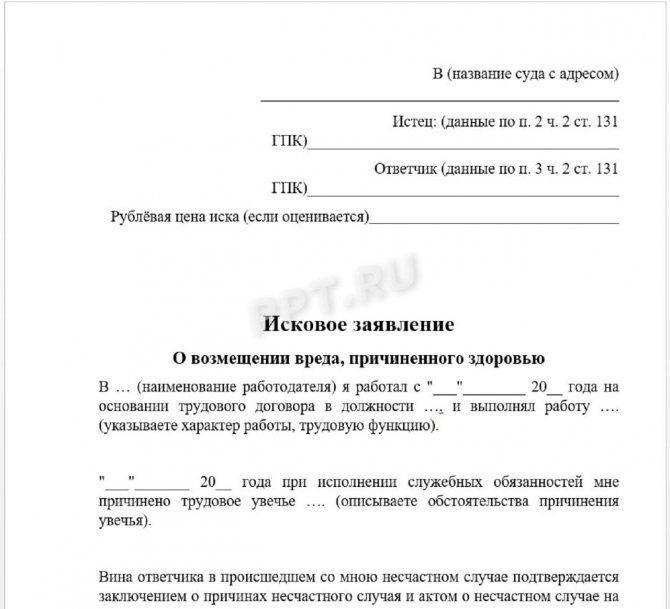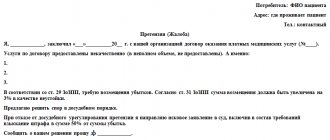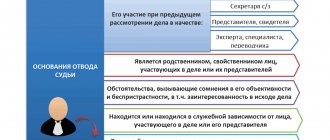Sample statements of claim to court against an employer
ATTENTION! Look at the completed sample claim for recovery of wages and monetary compensation for late payment:
You can DOWNLOAD samples of statements of claim to court against an employer using the links below:
- Claim for recovery of wages and monetary compensation for delay in payment
- Statement of claim for recovery of monetary compensation for unused vacation upon dismissal of an employee
- Statement of claim for recovery of unpaid premium
- Statement of claim for recovery of severance pay
- Statement of claim for recovery of wages due to delay in issuing a work book
- Statement of claim against an employer for non-payment of wages
- Statement of claim against an employer for illegal dismissal
- Statement of claim to the court against the employer for the recovery of funds
- Statement of claim to court against the employer for failure to issue a work book
- Statement of claim against an employer for refusal of employment
- Suing an employer for discrimination
- Statement of claim to court against employer for dismissal
- Statement of claim to court against employer for payment of bonus
Drawing up a statement of claim
The main document for a case to proceed in court is a statement of claim. The outcome of the case may depend on the correctness of its preparation.
Also on the topic: Can an employer reduce salary unilaterally?
A statement of claim to court against an employer must contain the following details:
- the name of the court in which the case will be heard. In this situation, it is located at the location of the defendant. Even if an employee mistakenly sends documents to his place of residence, they will most likely be forwarded to the necessary court; this will take some time;
- all data of the Plaintiff, that is, the person who filed the statement of claim, this includes: full name, passport details, date of birth, place of registration and residence (if different);
- all the data of the Defendant that is known to the Plaintiff, in this case this is the full name of the organization, its TIN, legal and actual addresses;
- the text of the statement of claim, this part is the most important, it should be drawn up in as much detail and clearly as possible. The main thing is to state the Plaintiff’s demands as clearly and completely as possible and justify them.
Remember! The court considers only those claims that will be indicated in the statement of claim. Submitting additional claims may be rejected or take a long time.
- calculations of all due amounts, this is mandatory if we are talking about the payment of funds. The plaintiff must describe in detail how this or that amount required by him arose.
- the Plaintiff's signature and the date the document was drawn up.
Download the statement of claim to the court against the employer (sample)
Order drawing up a statement of claim >>
Rules for drawing up an application
Economic problems periodically bring to the surface issues related to delays or non-payment of wages. Naturally, the employee, not wanting to quarrel with his employer, tries to ensure that the money he earns is paid to him.
However, if persuasion and persuasion do not bring any benefit, a person is forced to seek legal protection. The completed statement of claim is submitted to the district court according to the territorial location of the employer.
Typically, the legal address coincides with the actual location of the central office of an enterprise, organization or institution.
Attention! At the same time, the employer’s structures may be located in several places, geographically distant from each other, and in some cases, in other populated areas. In this case, the claim should still be filed at the location of the main office.
When drawing up a statement of claim, you should adhere to the rules established by Article 131 of the Civil Procedure Code of the Russian Federation.
This rule contains an exhaustive list of issues that must be reflected in the statement of claim. If you ignore this requirement, the claim will be returned without consideration.
Introductory part
Remember! In order for the court to accept documents for consideration, the following information must be indicated in the introductory part of the statement of claim:
- the full name of the judicial authority in whose name the document was drawn up, its address indicating the postal code, name of the locality, street and house number,
- information about the plaintiff, which should include the last name, first name, patronymic, address of his place of residence, means of communication in the form of a telephone number or email address,
- information about the defendant, consisting of the full name of the legal entity or individual entrepreneur, INN and KPP, by which this person can be identified. Legal and actual address of the location indicating the postal code, name of the locality, street, house, building, and so on. Communication means in the form of telephone, fax, email,
- the cost of the claim, that is, the exact amount of back wages that should be recovered from the employer.
The document itself must contain the following text: “Statement of Claim.” It is located in the middle of the sheet. Below, also in the middle, there is a clarification of what the plaintiff is going to court with: “for the recovery of wages.”
Attention! Our qualified lawyers will assist you free of charge and around the clock on any issues. Find out more here.
Descriptive part
The descriptive part of the statement of claim is intended to set out the factual circumstances that served as the basis for seeking judicial protection.
Remember! Information should be presented briefly, clearly, legally competently, adhering to the order of occurrence of circumstances:
- when the employment relationship between the parties began,
- on what terms the employment contract was concluded,
- what work was entrusted to the plaintiff, or what functional duties he performs,
- in what order and in what amount should labor be paid according to the employment contract,
- how the employer actually paid the employee,
- what are the violations on the part of the employer,
- what labor laws have been violated?
- what measures the employee took to resolve the controversial situation,
- what was the reaction from the employer,
- how much the employer owes and for how long.
How to file a complaint against an employer?
What should you pay attention to?
The debt that is supposed to be recovered from the employer may include not only the wage debt itself.
Thus, the Labor Code provides:
- For violation of the terms of payment of wages, the employer, on the basis of Article 236 of the Labor Code, is also obliged to pay monetary compensation for each day of delay. Its size is 1/150 of the refinancing rate of the Central Bank of the country from the amount of debt for each day of delay,
- In addition, Articles 21 and 22 of the Labor Code provide the employee with the right to file claims for compensation for moral damage caused by non-payment or late payment of wages. The amount of such compensation may be determined by an individual or collective labor contract. If nothing is said about such a measure in these documents, then the court, at its own discretion, determines the amount of compensation for moral damage caused.
The operative part
The conclusion sets out the requirements presented to the defendant.
Please note! Typically, the operative part of the statement of claim contains several points:
- recover from the defendant the amount of arrears of wages,
- to recover monetary compensation for violation of deadlines for payment of wages,
- to recover compensation for moral damage caused,
- assign legal costs to the defendant. They involve a state fee and the services of a lawyer hired by the plaintiff. Article 333.36 of the Tax Code exempts the plaintiff from paying state duty when going to court, but the guilty person, after making a decision, is obliged to pay the duty to the state. This may be the defendant, if the claim is satisfied, or the plaintiff himself, if the claim is denied.
Before signing the statement of claim, you should outline the list of documents that are attached.
Watch the video. How to properly draw up a claim in court and submit it:
How to sue your employer
To the Moskovsky District Court of St. PetersburgPlaintiff: Timokhin Dmitry Olegovich
address: 123456, St. Petersburg, Gusarov Avenue, building 20, building 1, apartment 21
telephone
Defendant: Limited Liability Company "Iskra"
address: 123456, St. Petersburg, First Lane, building 21, room 12
telephone
INN: 7930681111
OGRN: 1137745112233
Cost of claim: 25,915 (twenty-five thousand nine hundred and fifteen) rubles
The state duty is not paid in accordance with subparagraph 1 of paragraph 1 of Article 333.36 of the Tax Code of the Russian Federation
Lawsuit
on the recognition of relations arising from a civil contract as labor relations and the obligation of the employer to draw up an employment contract and make an entry in the work book
In July 2021, an agreement for the provision of paid services (hereinafter referred to as the Agreement) was concluded between the Plaintiff and the Defendant, according to which the Plaintiff accepted the obligation to personally and for a fee perform the following work:
- Conducting information and consulting activities (classes, consultations, seminars, trainings, etc., aimed at providing knowledge, developing skills in various areas, developing intellectual and creative abilities) for persons who are clients of the Defendant.
- By providing oral and written advice to the Defendant and persons indicated by the Defendant as his clients.
- Providing marketing services (participation in exhibitions, visiting schools, etc.).
- On organizing information and consulting events by persons indicated by the Respondent.
- Other work as directed by the Respondent.
In September 2021 and September 2021, the Defendant and the Plaintiff re-signed the Agreement, but the content of the subject matter of the Agreement remained unchanged throughout the entire period, including after its repeated re-conclusion. Despite the fact that the work was performed by the Claimant from August 2021 to the present, no employment contract was concluded with him.
Meanwhile, the existence of an employment relationship between the Plaintiff and the Defendant is confirmed by the following circumstances:
- The Plaintiff successfully completed training in courses organized by the Defendant, and based on the results of this training, an Agreement was signed with the Plaintiff, and a Teacher Course Certificate was issued, confirming that the Plaintiff is a teacher of the company;
- the work is performed by the Plaintiff personally - the Plaintiff’s responsibilities as a teacher include regularly conducting classes in his group, carrying out ongoing monitoring of students’ progress by conducting tests and tests, as well as theoretical tests, checking students’ homework (Article 1.5.7. - 1.5. 15. Agreement). The provisions of the Agreement do not provide for the possibility for the Plaintiff to engage third parties at its discretion to carry out the subject of the Agreement; performance of the work requires the personal presence of the Plaintiff as a teacher in the classroom during an in-person lesson and in a specially equipped room (webinar) for conducting distance learning (Article 2.10.20 . Agreement);
- the work is performed according to a schedule (curriculum) and class schedule (schedule) pre-planned by the Defendant - the Claimant is not free to choose the place and time of performing his work, the schedule and schedule of classes cannot be changed by the Claimant, classes (lessons and webinars) are limited to time intervals, determined by the Defendant, which is confirmed by the protocol of inspection by a notary of written evidence - materials on the Internet;
- The Defendant provides the Plaintiff with equipment, tools, technical documentation and other means necessary for the Plaintiff to fulfill its obligations under the Agreement - the Plaintiff performs its duties in a specially equipped room - a classroom or webinar, which are located on the territory of the Defendant at the address: St. Petersburg, st. Pravdy, building 11, room 12. Moreover, the Plaintiff conducts each lesson in strict accordance with the educational and methodological complex developed by the Defendant, which describes in detail the procedure for conducting each lesson, and also uses the Course Book - a practical guide developed by the Defendant for students to solve specific tasks in the format Unified State Examination (Article 2.15.10 of the Agreement), the Plaintiff uses the Defendant’s equipment to perform his work, in particular a computer, web camera and headset, which are located in the webinar and which are intended for conducting distance classes (Article 1.3.14 of the Confidentiality Agreement ), while the Plaintiff does not bear any financial expenses in connection with the use of the Defendant’s premises, equipment and other materials;
- The Plaintiff performs its work in the interests of third parties - the Defendant's clients, with whom the Plaintiff is not bound by any contractual obligations (Articles 1.12.1 - 1.12.5 of the Agreement);
- the work is performed in accordance with the instructions and under the control of the Defendant, who controls the appearance of the Plaintiff at the workplace (Article 2.1 of the Rules of Professional Ethics and Ethics of Business Communication), the time the Plaintiff arrives at the workplace and the time the Plaintiff leaves the workplace, which is determined by the Defendant schedule, the Defendant’s instructions regarding the Plaintiff’s interaction with the Defendant’s clients are mandatory for the Plaintiff (Article 12.44.4 of the Agreement);
- The Plaintiff is integrated into the organizational structure of the Defendant - subordinate to the team leader of the natural and social directions of the Department of Product and Teaching, subject to local regulations that are adopted by the Defendant and regulate the interaction of the Plaintiff with his immediate supervisor (team leader), as well as with employees of other structural divisions of the Defendant (to such acts include the Rules of Professional Ethics and Ethics of Business Communication and the Confidentiality Agreement);
- the nature of the work does not imply an end result, which indicates a certain continuity in the work of the Plaintiff: The contract for the provision of paid services was concluded for 12 months, the end of the Agreement is not tied to any final result. If the Defendant does not need the Plaintiff to conduct classes, the Defendant entrusts the Plaintiff with other work, for example, participation in the revision of the Defendant’s educational and methodological complex in order to update it for the next academic year;
- The Defendant makes regular monthly payments to the Plaintiff as remuneration for work, which are calculated based on the hourly rates established by the Defendant, which is confirmed by the notary’s inspection protocol of written evidence - materials on the Internet. No later than the 15th day of each month, the Plaintiff’s account receives funds from the Defendant (Article 5.4.2 of the Agreement), which is confirmed by Sberbank certificates on transactions;
- the remuneration paid by the Defendant to the Plaintiff is the main source of income for the Plaintiff, as confirmed by the Notice of the status of the individual personal account of the insured person;
- The Defendant pays for the Plaintiff's travel undertaken by the Plaintiff in order to perform work: The Defendant provides the Plaintiff with air and railway tickets for business trips, and also compensates for the funds spent by the Plaintiff on taxi trips that are directly related to his work, which is confirmed by the protocol of inspection of written documents by a notary evidence - materials on the Internet, as well as Sberbank certificates on transactions and receipts for taxis;
- The Plaintiff does not bear financial risks associated with its obligations with the Defendant, that is, the Agreement does not provide for penalties and fines that the Plaintiff must pay to the Defendant in the event of improper performance or failure by the Plaintiff to fulfill its obligations under the Agreement. However, the contract provides for property damages (Article 1.7.2 and Article 1.7.6 of the Agreement) and disciplinary (Article 2.5.1 of the Confidentiality Agreement) for violation by the Plaintiff of the Confidentiality Agreement, as well as for violation of labor discipline (Article 5.7 4. - 5.7.5. Agreement).
In accordance with Art. 15 of the Labor Code of the Russian Federation, labor relations are relations based on an agreement between the employee and the employer on the personal performance by the employee for payment of a labor function (work according to the position in accordance with the staffing table, profession, specialty indicating qualifications; the specific type of work entrusted to the employee), in the interests, under the management and control of the employer, the employee’s subordination to internal labor regulations while the employer provides working conditions provided for by labor legislation and other regulatory legal acts containing labor law norms, a collective agreement, agreements, local regulations, and an employment contract.
According to Part 1 of Article 19.1 of the Labor Code of the Russian Federation, recognition of relations arising on the basis of a civil contract as labor relations can be carried out:
- by a person who uses personal labor and is a customer under the specified contract, on the basis of a written statement from an individual who is a performer under the specified contract, and (or) an order of the state labor inspector to eliminate the violation of Part 1 of Article 15 of the Labor Code of the Russian Federation that has not been appealed to the court in the prescribed manner Federations;
- by the court in the event that an individual who is a executor under the specified agreement appealed directly to the court, or based on materials (documents) sent by the state labor inspectorate, other bodies and persons with the necessary powers in accordance with federal laws.
05/11/2020 The plaintiff sent an Application for recognition of relations arising on the basis of a civil contract as labor relations, which has so far been left unanswered on the merits.
The above-mentioned actions of the Defendant in refusing to recognize the existing relationship between the Plaintiff and the Defendant as an employment relationship caused the Plaintiff’s moral distress, and therefore he believes that he also suffered moral damage, which is subject to compensation on the basis of Article 237 of the Labor Code of the Russian Federation and the amount of which The plaintiff estimates it at 5,000 (five thousand) rubles 00 kopecks.
The claim is calculated as follows: the price of the claim (25,915 (twenty-five thousand nine hundred fifteen) rubles) consists of the amount of legal expenses (20,915 (twenty thousand nine hundred fifteen) rubles), which consists of the amount of expenses for notary services, which is confirmed by receipts from notary Tarakanova A.I. dated 05/04/2020 and 05/11/2020, and the amount of compensation for moral damage (5,000 (five thousand) rubles).
Based on the above and guided by Articles 15, parts 1, 3 of Article 16, Articles 19.1, 56, 57, 67, 135, 237, 391, 392, 395 of the Labor Code of the Russian Federation, paragraph 12 of the Resolution of the Plenum of the Supreme Court of the Russian Federation dated March 17, 2004 No. 2 “On the application by the courts of the Russian Federation of the Labor Code of the Russian Federation”, paragraph 6.3 of Article 29, articles 131, 132 of the Civil Procedure Code of the Russian Federation,
ASK:
- Establish the fact of the existence of an employment relationship between the Plaintiff and the Defendant.
- Oblige the Defendant to conclude an employment contract with the Plaintiff as of August 19, 2018 and make a corresponding entry in the work book.
- To recover from the Defendant an amount of compensation for moral damage in the amount of 5,000 (five thousand) rubles.
- To recover from the Defendant legal costs (notarial provision of evidence) in the amount of 20,915 (twenty thousand nine hundred fifteen) rubles.
Applications:
- Diploma of completion of teacher training course.
- Contract for paid services dated 07.2018.
- Contract for paid services dated 09.2018.
- Contract for paid services dated 09.2019.
- Rules of professional ethics and ethics of business communication (Appendix No. 4 to the Agreement).
- Confidentiality agreement dated June 12, 2018.
- Additional agreements to the contract for the provision of information and consulting services and Certificates of acceptance of information and consulting services performed under the Agreement for the period from 04/30/2019 to 11/30/2019.
- Protocols of inspection by a notary of written evidence - materials on the Internet
- Receipt from a notary.
- A copy of the Notice of the status of the individual personal account of the insured person.
- Proof of monthly receipt of funds into the Plaintiff’s account: Sberbank certificates on transactions.
- Proof of payment by the Defendant for the Plaintiff's business trips by taxi: bank statements for transactions and receipts for taxis.
- Proof of payment by the Defendant for business trips of the Plaintiff: air tickets and railway tickets in the name of the Plaintiff.
- A copy of the Application for recognition of relations arising on the basis of a civil contract as labor relations dated 02/11/2020.
- Documents confirming the sending to the Defendant of the Application for recognition of relations arising on the basis of a civil contract as labor relations and the documents attached to it (check, list of attachments and notification of delivery).
- Documents confirming the sending to the Defendant a copy of the statement of claim and documents attached to it that the Defendant does not have (check and list of attachments).
Plaintiff
Attached documents
Attention! Such documents may include official papers that prove the validity of the stated claim:
- The order of acceptance to work,
- employment contract,
- regulations on remuneration at the enterprise,
- collective agreement,
- order of dismissal, if a dispute has reached this point,
- materials of internal investigations, if any,
- instructions from the labor inspectorate,
- statement of receipts on a salary card,
- monthly payslips,
- other documents that may be relevant to the dispute.
All attached documents are attached in copies. However, you should have the originals with you, as the court is obliged to verify their identity.
Complaint to the labor inspectorate about non-payment of wages.
What is included with the claim?
Documents from Art. 132 of the Code of Civil Procedure of the Russian Federation - evidence for a specific situation and mandatory applications:
- power of attorney of the representative - lawyer, if involved;
- documents of pre-trial settlement with the defendant (claim and response to it), if complied with. Pre-trial settlement may be specified in the employment contract;
- documents on conciliatory actions, if they were carried out and the documents are available;
- calculating the cost of the claim if there is a lot of data;
- a document on sending to the defendant copies of the claim and other attachments that he does not have (notification);
- employer orders (on hiring, punishment, dismissal);
- employment contract;
- employment history;
- payslips;
- statement of receipts to your bank account;
- certificate 2-NDFL;
- labor protection regulations;
- inner order rules;
- other evidence—substantiation of your position. Support any of your statements from the statement of claim with evidence.
Also on the topic: How to refuse a job applicant
The evidence required from the employer is provided to the plaintiff upon his written application (Article 62 of the Labor Code). Upon a written application from the plaintiff, the court helps to collect evidence. Copies of documents are attached to the claim (preferably indicating the number of pages for each), and their originals are brought to the court hearing.

Reasons for filing an application to court

A labor conflict that is not resolved peacefully always turns into litigation.
As judicial practice shows, employees most often seek judicial protection on the following issues:
- dismissal from work without complying with the requirements of labor legislation,
- long delays in payment of wages,
- violation of the terms of the employment contract by the employer or its administration,
- delay in issuing settlement funds upon dismissal,
- incorrect calculation when dismissing an employee,
- refusal to pay vacation pay when going on maternity leave,
- non-payment of a lump sum benefit upon the birth of a child,
- failure to pay child care benefits until the child is one and a half years old,
- refusal to pay for work performed during unofficial employment,
- refusal to hire.
Before filing a claim in court, it is recommended to contact the labor inspectorate, which has sufficient powers to resolve the dispute. Sometimes it is enough to write a complaint to the prosecutor's office. If such measures are unsuccessful and the labor conflict is not resolved, you should go to court.
Pre-trial settlement
Many employers prefer to have a lawyer on staff who can resolve a labor conflict if it arises. Such a specialist will be able, from a legal point of view, to outline steps for each of the parties so as not to bring the case to court.
Thanks to this approach you can:
- quickly and without incident to resolve a controversial situation, since court proceedings take not only a lot of time, but also physical effort, and have a negative effect on the morale of each party to the conflict,
- resolve the situation to the benefit of each party, maintain normal labor relations, keep a valuable employee at work,
- protect the parties from additional financial costs.
Attention! Certain conflict situations require a mandatory pre-trial procedure for resolving the dispute before going to court. If such a requirement is ignored, the court will refuse to accept the claim for consideration.
This procedure may be provided:
- international treaties,
- current legislation,
- individual or collective labor contract.
To comply with these requirements, you must submit a complaint to the employer in writing, outlining which employee rights have been violated and how the conflict should be resolved. The letter should be registered in the employer's office or sent by post with a list of the contents and a return receipt.
The text of the claim itself must be presented in a legally correct manner, with reference to current legislation, without causing insults. You can do it by hand or print it on an A4 sheet.
Remember! It is recommended that the content of the claim letter be presented in the same structure as the claim itself:
- name of the employer, its legal address,
- surname, name, patronymic of the employee, position held, address of residence,
- title of the document, for example, “Claim for settlement of a labor dispute”,
- description of facts of violations of labor legislation committed against the applicant,
- requirements for the settlement of a labor dispute,
- date and signature of the employee.
Complaint to the labor inspectorate about violation of labor rights.
Jurisdiction of a labor dispute
Claims for the resolution of labor disputes are considered by the court at the territorial registration of the employer. However, which court will hear the case: district or magistrate - depends on the amount of the claim claimed by the plaintiff.
So, with claims that do not exceed 50 thousand rubles, the case will go to the magistrate. If the amount is higher, the conflict will be resolved by the district court. In labor disputes where the price of the claim is not determined, the cases will be considered in district courts.
Attention! Their territorial jurisdiction is determined as follows:
- at the legal registration address of the defendant,
- at the address of the location of its structural unit,
- at the place of registration of the plaintiff, if we are talking about dismissal without legal grounds,
- at the address where the work is performed or the service is provided.
Limitation periods
If there is a violation of labor legislation, then there are limited time limits for going to court. For example, an employee who was fired illegally can defend his right in court only within one month after such separation from the employer.
The period begins on the second day when the employee was familiarized with the dismissal order or from the day he received the work book. At the same time, the employee’s deliberate actions in not receiving a work book will work against him.
In other cases of violation of labor legislation, the statute of limitations is set at three months from the day the employee learned or should have learned that his rights were violated.
In practice, it looks like this: wages under an employment contract are paid on the 28th of each month. If the worker has not received it on May 28, then he can go to court no later than August 28.

Is it possible to quit without working?
Do you have to pay wages if work is suspended? Read here.
What to do if you have lost your work book, read the link: https://novocom.org/otvety-na-voprosy-chitatelej/chto-delat-esli-poteryali-trudovuyu-knizhku.html
Judicial practice knows many examples when an employer formalizes dismissal retroactively and does not inform the employee about the date of such a decision. When going to court, it may turn out that the period for judicial protection has already passed.
In this case, the legislator allows the plaintiff to file a petition to restore the missed deadline. However, he must provide evidence that the deadline was missed for a good reason.
Unfair actions on the part of the employer force the employee, when familiarizing himself with any documents, to put only the actual date of familiarization and, in response to requests and persuasion, not to put the date or to put the required date - not to agree, since in the future this may turn against the employee himself.
Important! If the deadlines are met, then you can safely file a claim, attaching the necessary documents to it.
Deadlines for filing claims
Art. 392 of the Labor Code establishes the deadline for filing a lawsuit against an employer:
- for disputes about dismissal - a month from the date of delivery to the employee of a copy of the dismissal order, work book, or from the date of drawing up an act on the employee’s refusal to receive these documents;
- for disputes regarding the payment of amounts due to an employee - one year from the date of expiration of the deadlines established for the payment of these amounts;
- for other labor disputes - three months from the day the employee learned or is able to learn about the violation of his rights;
- for claims for compensation for harm to health - for an indefinite period (Article 208 of the Civil Code). If you file a claim later than three years from the date the right of claim arose (the damage was caused in 2015, and you file the claim in 2021), the damage will be compensated for the last three years.
If you missed the deadline for a good reason, petition the court to reinstate it, attaching evidence of the reasons for the missed deadline to the petition. Valid reasons are considered:
- appeal to the prosecutor's office, state labor inspectorate;
- plaintiff's illness;
- business trip;
- force majeure (natural disasters, epidemics, man-made disasters);
- caring for seriously ill family members.
Claims will be accepted outside these deadlines, but after the defendant’s request to skip the statute of limitations, the process will end (to no avail for the plaintiff).
Limitation periods for labor disputes
The statute of limitations for labor disputes is somewhat shortened and this must be kept in mind when preparing for the trial and must be taken into account and not waste time.
Thus, the statute of limitations for individual labor disputes is 3 months from the moment the employee learned or should have learned about the employer’s violation of his rights.
The statute of limitations for disputes related to dismissal is even shorter; it is only 1 month from the date of illegal dismissal, or rather 1 month from the date of issuance of the dismissal order or from the date of issuance of the work book.
Also on the topic: How to prepare a profile for a student from the place of study
In disputes about non-payment of wages, you have the right to go to court within 1 year from the date when such payments should have been made to you, but they were not. The category of these disputes includes disputes over non-payment of other remuneration due to the employee by law.
Therefore, we always advise not to delay filing a claim in court, especially in disputes about dismissal. Some people make a mistake and file a complaint against the employer with the labor inspectorate, and by law the labor inspectorate has the right to respond within 30 days from the date of filing the complaint. They file a complaint with the State Tax Inspectorate and sit and wait for the weather by the sea, but while they wait, the statute of limitations for dismissal passes, and for other violations it is reduced, and in a month they could have sorted out the problem in court, or before the trial on the claim. Of course, it is possible and sometimes necessary to file complaints with the State Tax Inspectorate, but this must be done in parallel with filing a claim in court or after filing a claim. In our opinion, the court is the most effective means in the fight against labor law violators.
Submitting documents to the court
Documents should be submitted to the court only on paper. The electronic form is not provided for by current legislation.
A statement of claim, drawn up in several copies and with attachments, can be filed in only two possible ways:
- hand over in person to the court office, requesting their registration and receiving an incoming number from the incoming correspondence log. Typically, such retaliation is affixed to a copy of the application, which remains with the plaintiff,
- send by post with a description of the contents and notification of delivery.
After submitting the documents, the court will set a court date, of which the parties will be notified by subpoenas.
Watch the video. Judicial practice in labor disputes:








